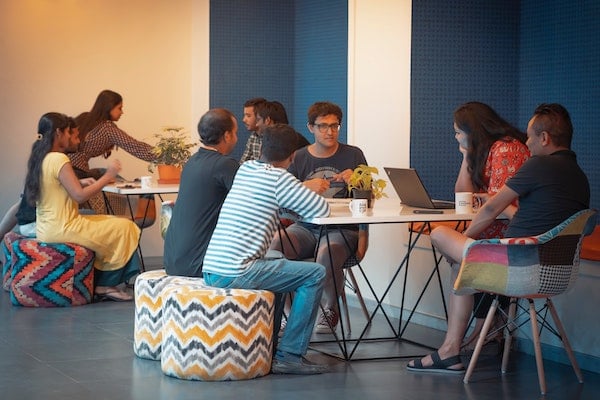Published on
Supporting Social Capital in Continuing Ed

Social capital is one of the main components to fostering the right institutional culture, and this connection needs to be streamlined into continuing ed. It is possible, but the very nature of non-degree programming and its infrastructure puts forth a tougher challenge of building the capital naturally. In this interview, Christine Brooks-Cappadocia and Heather McRae discuss social capital within non-degree offerings, its benefits, and why it’s important to develop social capital in continuing education.
The EvoLLLution (Evo): Historically, how much of a consideration has social capital been in the design and development of non-degree, adult or continuing education offerings?
Christine Brooks-Cappadocia (CBC): Historically, continuing education has stressed flexibility through individual courses offered in multiple formats. The current interest in microcredentials, which can be anything from a certificate to a digital badge, is accelerating this trend. However, much like more tangible forms of capital, social capital requires significant investments of time and effort to grow. While many non-degree programs attempt to build the soft skills required to build social capital, the very flexible structure through which we build and offer courses erodes efforts to build that capital. Students introduced to a particular professional competency–such as communication or collaboration–will get few opportunities to practice in any one course before it ends. Wherever they choose to deliberately practice any lessons they learn in that class, the conditions have invariably changed.
Heather McRae (HMR): Social capital is not a term that has been widely used in the design and development of adult and continuing education over the past decades; however, the principles relating to building community–acknowledging the skills and knowledge shared within the classroom setting by adult learners, an understanding of the importance of networks and exchanges as well as using real-life and relevant examples in teaching and learning–have always been defining characteristics of our programs and courses. The co-development of knowledge is an important part of adult learning given the rapid pace of new information and technologies, and the opportunity to share diverse experiences and approaches to learning.
Evo: How do students benefit from courses and programs where social capital development is built into the foundations?
CBC: Adults bring a wealth of experience with them into the classroom. They often present new information related to their experiences to try to make sense of it. That process requires sharing, and sharing requires trust. An environment that builds social capital also fosters trust. This type of environment is critical for adult learners.
What we’ve learned at York is that by offering our professional education programs in a cohort model, students get a more consistent environment in which to experiment and develop the skills that build social capital. The student community is consistent throughout the program, and the courses are deliberately designed to further strengthen the soft skills introduced in previous courses. In this environment, students get a better sense of how their social capital is impacted as they practice various soft skills. By the time students start the work-integrated learning elements of their programs, they’ve had a chance to practice and are able to demonstrate the professional competencies employers have identified as most often missing in the talent pool. Students are then able to draw on those experiences to solve real workplace problems and demonstrate their application of both the functional expertise – and perhaps more importantly – the professional competency in interview situations.
HMR: Incorporating social capital principles help continuing education practitioners embed social and emotional skills development into the curriculum. Skills such as effective dialogue and communication, problem-solving and resilience are critical to helping our students address change and ambiguity–conditions that are particularly prevalent today. Continuing educators offer courses focusing on applied learning that often require students to work in groups to identify and solve problems. This requires students to co-create solutions, and in doing so, explore their own approaches, identify their strengths and weaknesses and collectively seek the best possible result. Ruth Younie, a MacEwan University communications instructor, believes that students benefit from being “able to extend their community. They learn to recognize similarities in style, humour and also to accept differences. The network they establish in class often results in new jobs and new opportunities”.
Evo: Why is it particularly important for CE leaders to ensure their students are able to build social capital?
CBC: Our accelerated programs attract ambitious and high-achieving students by nature. There are many competing options for our students to engage in more self-directed forms of learning. Students come to us for something that they can’t get on their own. That includes the opportunity to build relationships in a community of like-minded people focused on their area of interest. We’ve seen that sense of community continue well beyond the classroom with alumni supporting each other and incoming students. Most of our programs focus on emerging fields that are relatively tightknit communities. Students and instructors will likely run into each other throughout their careers. The social capital our students build within the safety of the classroom environment will have benefits throughout their careers.
HMR: In my view, we are always thinking about the principles of social capital as it is foundational to our adult education practice. Many of our students face multiple barriers including limited English language skills, lack of family support (both financially and emotionally), previous negative experiences in education. Success within the adult education classroom is transformative for many of our students who can increase their confidence, discover a love of learning and benefit from peer support.
Evo: What are the most significant challenges to supporting social capital development—especially now, as more and more offerings shift to online, remote and distance modalities?
CBC: The ability to build strong social capital has to be built in from the onset of the program design process. You can’t just deliver a traditional in-class lecture over zoom and expect students will interact because you’ve asked a question to the group or added a discussion form.
Before COVID-19, most of our programs were delivered through a blend of a synchronous online learning and on-campus sessions. We used on-campus meetings to build rapport, engage in interactive activities and facilitate group projects. Our most skillful instructors would plant seeds in the face-to-face sessions that would be nurtured in the online environment once students were more comfortable with one another.
Now, we’re doing that in synchronous zoom sessions with smaller, less intimidating breakout rooms and assigning students an activity to foster purposeful interaction. Later on in the program, when students get a chance to apply their learning through micro-work integrated learning projects, the trust they’ve built in the breakout rooms carries into the virtual workspace. In some programs, this has been so well received by students that we plan to carry on offering a completely online section in addition to our more traditional blended sections when it becomes safe to resume on campus programs.
HMR: In the rush to move courses online in the spring, I think there was an emphasis on content rather than the process-oriented kinds of communication that are prevalent in face-to-face instruction as a result of informal discussions and questions. Online community development requires planning; it is more deliberate but can be achieved and very successfully at that. But it is not without challenges. According to Ruth Younie, “it’s harder to recognize the golden learning moments – and being able to shift to build on that moment – because sometimes the question just doesn’t come. I have had people tell me it takes too long to unmute, so they won’t ask a question”. Technology also provides challenges as some students do not have microphones or video, may be sharing computers or smart phones, have poor connectivity or might be uncomfortable using online tools. While technology lending programs have assisted with access, there are still some issues with connectivity.
Evo: What are a few best practices leaders can keep in mind to overcome these obstacles?
CBC: Take a collaborative approach with your community. Listen to your instructors and support them as they tackle this new way of teaching. Listen to your students as they tackle this new way of learning. Students will give you very useful feedback if they trust that you will consider it and act on their advice. Most of all, be thoughtful and deliberate in your efforts to create communities in the online environment but be ready to adapt your approach to support each class’s nuances.
HMR: One of my instructors shared the following suggestions. You want to start with an energizer or ice breaker. You need to be able to evaluate everyone’s comfort level and experience with online tools. Also, ask a lot of questions. This will get people talking and make them more comfortable. Another suggestion is to tell simple, family-friendly jokes. Use visual images or logic puzzles that the students have to solve. Encourage others to tell jokes
You also want to make sure you’re taking short stretch breaks. Make the students stand up and stretch, whether they are in a classroom or at a computer. Keep your video on (technology permitting) to let them see your face. Use breakout groups. Jump into the breakout groups and check on how everyone is doing. Try to build the same breakout groups for multiple questions/exercises. More time-consuming for you but better for the students.
Most importantly, get comfortable. Get very, very comfortable and confident with the technology. Don’t let it be a barrier! I’ve been in settings where the facilitator got mad at the computer. It was more than distracting–it was a shutdown for me. Use the polling function, have students write on the virtual whiteboard, and most importantly, have fun.
This interview was edited for length and clarity.
Disclaimer: Embedded links in articles don’t represent author endorsement, but aim to provide readers with additional context and service.



